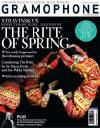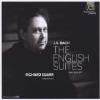Texte paru dans: / Appeared in:
*

GRAMOPHONE (03/2013)
Pour s'abonner /
Subscription information
Harmonia Mundi
HMU907591.92

0093046759124 (ID289)
Decrypting Bach
Lindsay Kemp talks to Richard Egarr about Bach’s enigmatic
English Suites
As I ride the lift to the top-floor bar of the London hotel where I have
arranged to meet Richard Egarr, I know what to expect: energetic talk, jollity,
a few funny voices, and behind it all flashes of a high level of musicianship
and engagement in the music of Bach. Egarr is one of those relatively rare
harpsichordists who combines a busy conducting career — he has been music
director of the Academy of Ancient Music since 2006 — with substantial
involvement as a solo artist not just in a few minor areas of the repertoire but
in the major works of Bach. His recordings of the Goldberg Variations and
Book 1 of the ‘48’ for Harmonia Mundi have already won plaudits and we are here
now to discuss his latest project — the six so-called English Suites. He
characterises them for me as ‘large-scale and grand, with immense concerto-like
Preludes. An interesting collection, too, because of how it was put together —
you can really see a development of the musical material as you go through the
set, particularly in the Gigues, culminating in the completely mad and manic
final one with its diabolical twists and weird chromatic harmonies.’
We have both brought scores with us, though in different editions, and soon we are leafing through them. ‘I had three or four different editions actually,’ says Egarr. ‘For the recording I just used the one with the best-placed page-turns. As I tell my students, it’s all right buying an Urtext but you absolutely have to compare them all and read the reams of editorial commentary that go with them, otherwise you’re just trusting whoever edited it. That’s especially true with the English Suites, which don’t survive in the composer’s manuscript. And I’l confess I even changed one note in the G minor Allemande — a B flat to a B natural in the right hand in bar 10. Very naughty, but I just fancied it; it’s already a very strange bit of writing for Bach there and I wanted to make it even more smelly.’
Egarr gets most excited on the subject of number symbolism. The theory that Bach used symbolic number relationships to shape the structure or even the melody of a piece has little or no basis in written verbal evidence, but from his own experience of the notes Egarr is a firm believer. In the English Suites the crucial numbers would seem to be one (representing God), three (the Trinity) and seven (heavenly perfection): ‘There are lots of structural multiples of three and seven in the Third Suite,’ he explains. ‘The fugal theme in the Prelude is based on a three-note motif of a descending third, and there are six entries which end at bar seven. And the first ritornello ends at bar 33. Then in the E minor Prelude you get this crucifix-shaped fugal motif which enters in bars one, three and seven.’
Egarr’s fingers fly across the pages as he points out these things (and more), and it is easy to find one’s head spinning. But this is scholarly stuff; is it possible to be aware of it when actually playing the music? ‘I think so,’ Egarr says, ‘because it’s something I’m used to thinking about when I approach the music, and because I have a deep feeling that it was part of the way Bach constructed his music, the way he lived and breathed it.’
The English Suites’ title is an enigma; it comes from an 18th-cenrury manuscript copy in which they were said to be ‘fait pour les Anglois’. But Egarr has a tentative answer to the suggestion that there is nothing specifically English in them. ‘This is slightly left-field, but it wouldn’t surprise me if they were written with Handel in the background. Handel’s Suites were published in London in 1720, and when I play the Bach I get the feeling that there are a lot of similar sequences and harmonic gestures. Maybe he’d come across them and they’d inspired him to write a big-scale bunch of suites of his own. Who knows?
Cliquez l'un ou l'autre
bouton pour découvrir bien d'autres critiques de CD
Click either button for many other reviews


